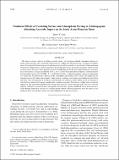Nonlinear Effects of Coexisting Surface and Atmospheric Forcing of Anthropogenic Absorbing Aerosols: Impact on the South Asian Monsoon Onset
Author(s)
Lee, Shao-Yi; Shin, Ho-Jeong; Wang, Chien
DownloadLee-2013-Nonlinear Effects of.pdf (4.220Mb)
PUBLISHER_POLICY
Publisher Policy
Article is made available in accordance with the publisher's policy and may be subject to US copyright law. Please refer to the publisher's site for terms of use.
Terms of use
Metadata
Show full item recordAbstract
The direct radiative effect of absorbing aerosols consists of absorption-induced atmospheric heating together with scattering- and absorption-induced surface cooling. It is thus important to understand whether some of the reported climate impacts of anthropogenic absorbing aerosols are mainly due to the coexistence of these two opposite effects and to what extent the nonlinearity raised from such coexistence would become a critical factor. To answer these questions specifically regarding the South Asia summer monsoon with focus on aerosol-induced changes in monsoon onset, a set of century-long simulations using the Community Earth System Model, version 1.0.3 (CESM 1.0.3), of NCAR with fully coupled atmosphere and ocean components was conducted. Prescribed direct heating to the atmosphere and cooling to the surface were applied in the simulations over the Indian subcontinent, either alone or combined, during the aerosol-laden months of May and June. Over many places in the Indian subcontinent, the nonlinear effect dominates in the changes of subcloud layer moist static energy, precipitation, and monsoon onset. The surface cooling effect of aerosols appears to shift anomalous precipitative cooling away from the aerosol-forcing region and hence turn the negative feedback to aerosol-induced atmospheric heating into a positive feedback on the monsoon circulation through latent heat release over the Himalayan foothills. Moisture processes form the critical chain mediating local aerosol direct effects and onset changes in the monsoon system.
Date issued
2013-08Department
Massachusetts Institute of Technology. Center for Global Change ScienceJournal
Journal of Climate
Publisher
American Meteorological Society
Citation
Lee, Shao-Yi, Ho-Jeong Shin, and Chien Wang. “Nonlinear Effects of Coexisting Surface and Atmospheric Forcing of Anthropogenic Absorbing Aerosols: Impact on the South Asian Monsoon Onset.” J. Climate 26, no. 15 (August 2013): 5594–5607. © 2013 American Meteorological Society
Version: Final published version
ISSN
0894-8755
1520-0442
